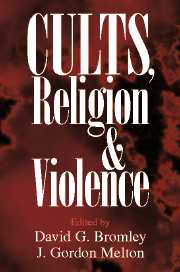Book contents
- Frontmatter
- Contents
- Acknowledgments
- Contributors
- Prologue
- 1 Violence and Religion in Perspective
- 2 Dramatic Denouements
- 3 Challenging Misconceptions about the New Religions–Violence Connection
- 4 Sources of Volatility in Religious Movements
- 5 Crises of Charismatic Legitimacy and Violent Behavior in New Religious Movements
- 6 Public Agency Involvement in Government–Religious Movement Confrontations
- 7 Watching for Violence: A Comparative Analysis of the Roles of Five Types of Cult-Watching Groups
- 8 Mass Suicide and the Branch Davidians
- 9 Occult Masters and the Temple of Doom: The Fiery End of the Solar Temple
- 10 Dramatic Confrontations: Aum Shinrikyô against the World
- 11 Making Sense of the Heaven's Gate Suicides
- 12 Lessons from the Past, Perspective for the Future
- Index
- References
10 - Dramatic Confrontations: Aum Shinrikyô against the World
Published online by Cambridge University Press: 09 July 2009
- Frontmatter
- Contents
- Acknowledgments
- Contributors
- Prologue
- 1 Violence and Religion in Perspective
- 2 Dramatic Denouements
- 3 Challenging Misconceptions about the New Religions–Violence Connection
- 4 Sources of Volatility in Religious Movements
- 5 Crises of Charismatic Legitimacy and Violent Behavior in New Religious Movements
- 6 Public Agency Involvement in Government–Religious Movement Confrontations
- 7 Watching for Violence: A Comparative Analysis of the Roles of Five Types of Cult-Watching Groups
- 8 Mass Suicide and the Branch Davidians
- 9 Occult Masters and the Temple of Doom: The Fiery End of the Solar Temple
- 10 Dramatic Confrontations: Aum Shinrikyô against the World
- 11 Making Sense of the Heaven's Gate Suicides
- 12 Lessons from the Past, Perspective for the Future
- Index
- References
Summary
In August 1994, some months before the March 1995 nerve gas attack on the Tokyo subway that brought the Japanese new religion Aum Shinrikyô to world attention, Murai Hideo, then head of Aum's science and technology “ministry,” informed a fellow devotee that “the time for confrontation” with the Japanese police was at hand (Takahashi 1997: 148). Acting on the orders of the movement's charismatic founder and leader, Asahara Shôkô, Murai supervised a number of Aum devotees in “secret work” manufacturing chemical weapons without the knowledge of the bulk of the movement's membership. This project was undertaken in preparation for the catastrophic endtime scenario that Asahara prophesied would occur by the close of the twentieth century in which the forces of evil would seek to destroy the movement. Aum had a sacred duty to stand up and fight for the truth and to defend itself against the “conspirators,” who Asahara claimed were intent on destroying Aum, and to wreak vengeance on its enemies.
In other words, while from any normative standpoint Aum's manufacture and use of chemical weapons appear as acts of aggression, in the eyes of the movement's leaders they were defensive moves aimed at protecting its mission and fighting for the truth against hostile enemies. Aum Shinrikyô had encountered a great deal of antipathy, hostility, and conflict from various quarters, including hostile media treatment and concerted opposition campaigns by the families of devotees, disgruntled former members, and their lawyers.
- Type
- Chapter
- Information
- Cults, Religion, and Violence , pp. 189 - 208Publisher: Cambridge University PressPrint publication year: 2002
References
- 3
- Cited by

